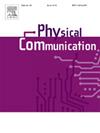空对地无线通信系统物理传输机制分析
IF 2.2
4区 计算机科学
Q3 ENGINEERING, ELECTRICAL & ELECTRONIC
引用次数: 0
摘要
本文提出了一种专门为空对地(A2G)通信系统设计的三维几何型随机信道模型(GBSM)。该模型通过模拟无人机、地面终端的机动性和散射簇的随机行为,集成了动态环境相互作用。该模型通过捕获无人机的轨迹动力学,包括旋转角度和不同的飞行姿态,准确地反映了航空通信环境固有的非静止特性。此外,还纳入了城市和郊区常见的建筑物、植被和其他障碍物造成的动态阻塞效应,以增强环境的真实感。考虑了视距(LoS)和非视距(NLoS)传播场景,以全面表征不同操作条件下的信道行为。随后,系统地推导并检验了关键信道特征的解析表达式,包括空间互相关函数(CCFs)、时间自相关函数(ACFs)、频率相关函数(ffs)和信道容量。仿真结果表明,该模型有效表征了快速时变的A2G传播条件,为下一代空中无线网络的性能评估和优化提供了可靠的框架。本文章由计算机程序翻译,如有差异,请以英文原文为准。
Analysis of physics-based transmission mechanism for air-to-ground wireless communication systems
This paper presents a three-dimensional (3D) geometry-based stochastic channel model (GBSM) specifically designed for air-to-ground (A2G) communication systems. The proposed model integrates dynamic environmental interactions by modeling the mobilities of unmanned aerial vehicles (UAVs), ground terminals, and stochastic behaviors of scattering clusters. By capturing UAV trajectory dynamics, including rotation angles and varying flight attitudes, the model accurately reflects the non-stationary characteristics inherent to aerial communication environments. Moreover, dynamic blockage effects caused by buildings, vegetation, and other obstacles commonly encountered in urban and suburban areas are incorporated to enhance environmental realism. Both line-of-sight (LoS) and non-line-of-sight (NLoS) propagation scenarios are considered to comprehensively characterize the channel behavior under diverse operational conditions. Subsequently, analytical expressions for key channel characteristics, including spatial cross-correlation functions (CCFs), temporal auto-correlation functions (ACFs), frequency-correlation functions (FCFs), and channel capacity, are systematically derived and examined. Simulation results demonstrate that the proposed model effectively characterizes the rapidly time-varying A2G propagation conditions, offering a reliable framework for performance evaluation and optimization in next-generation aerial wireless networks.
求助全文
通过发布文献求助,成功后即可免费获取论文全文。
去求助
来源期刊

Physical Communication
ENGINEERING, ELECTRICAL & ELECTRONICTELECO-TELECOMMUNICATIONS
CiteScore
5.00
自引率
9.10%
发文量
212
审稿时长
55 days
期刊介绍:
PHYCOM: Physical Communication is an international and archival journal providing complete coverage of all topics of interest to those involved in all aspects of physical layer communications. Theoretical research contributions presenting new techniques, concepts or analyses, applied contributions reporting on experiences and experiments, and tutorials are published.
Topics of interest include but are not limited to:
Physical layer issues of Wireless Local Area Networks, WiMAX, Wireless Mesh Networks, Sensor and Ad Hoc Networks, PCS Systems; Radio access protocols and algorithms for the physical layer; Spread Spectrum Communications; Channel Modeling; Detection and Estimation; Modulation and Coding; Multiplexing and Carrier Techniques; Broadband Wireless Communications; Wireless Personal Communications; Multi-user Detection; Signal Separation and Interference rejection: Multimedia Communications over Wireless; DSP Applications to Wireless Systems; Experimental and Prototype Results; Multiple Access Techniques; Space-time Processing; Synchronization Techniques; Error Control Techniques; Cryptography; Software Radios; Tracking; Resource Allocation and Inference Management; Multi-rate and Multi-carrier Communications; Cross layer Design and Optimization; Propagation and Channel Characterization; OFDM Systems; MIMO Systems; Ultra-Wideband Communications; Cognitive Radio System Architectures; Platforms and Hardware Implementations for the Support of Cognitive, Radio Systems; Cognitive Radio Resource Management and Dynamic Spectrum Sharing.
 求助内容:
求助内容: 应助结果提醒方式:
应助结果提醒方式:


